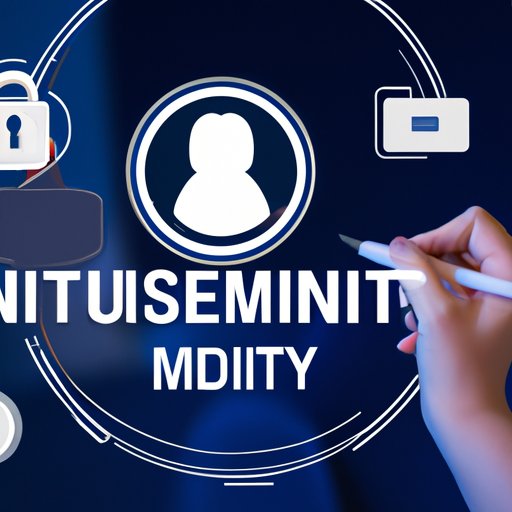
I. Introduction
Identity Management is an integral part of cybersecurity that helps individuals and organizations protect their digital identity and access control. With the rapid development and adoption of technology, our digital presence continues to expand, making our identity more susceptible to cyber threats. Therefore, understanding the basics of Identity Management is crucial to safeguard our digital identity and personal information. This article aims to explore what Identity Management is, its principles, implementation, advantages and limitations, recent trends and developments in Identity Management technology, and proactive measures to protect your identity online.
II. The Importance of Identity Management in Today’s Digital Age
Identity Management can be defined as the process of managing digital identities, including authentication, authorization, and access control. Identity Management is particularly important in today’s technology-driven world because of the increase in identity theft cases. Identity theft refers to the illegal acquisition and use of someone else’s personal information for fraudulent purposes. Unfortunately, identity theft has become prevalent in recent years, and the consequences of falling victim to identity theft can be dire. Victims of identity theft can suffer from financial loss, damage to their credit rating, emotional distress, and reputational harm.
III. Understanding the Basics of Identity Management: A Beginner’s Guide
Identity Management is a multidimensional process that involves several key components, including authentication, authorization, and access management. Authentication refers to the process of validating the identity of an individual or system, while authorization refers to the process of granting the appropriate level of access to the authenticated parties. Access management, on the other hand, refers to the process of controlling and managing user access to various resources.
At its core, Identity Management aims to provide secure and efficient access to resources while minimizing the risk of unauthorized access. To achieve this, Identity Management solutions employ fundamental principles, including the need for confidentiality, integrity, and availability. Confidentiality ensures that personal information is protected from unauthorized access, while integrity ensures that information is not tampered with or altered. Availability ensures that authorized users have access to resources when they need them.
There are several types of Identity Management solutions, including single sign-on (SSO), federated identity, and identity and access governance (IAG). SSO enables users to access multiple applications using a single set of credentials, while federated identity enables the sharing of identity information across multiple organizations. IAG involves monitoring and controlling access to sensitive data and applications, including enforcement of regulations and policies.
IV. The Advantages and Limitations of Identity Management Solutions
Identity Management solutions offer several advantages, including increased security, efficiency, compliance, and cost savings. By providing a centralized and streamlined approach to access control, Identity Management solutions help prevent unauthorized access and reduce the risk of data loss or theft. Additionally, Identity Management solutions can help organizations comply with regulatory requirements, such as HIPAA and GDPR, by providing necessary controls and auditing tools. Finally, Identity Management solutions can help reduce costs by minimizing the burden of user administration tasks.
Despite these advantages, Identity Management solutions also have limitations. The biggest barrier to adoption is often the complexity of implementation and maintenance, making them inaccessible to smaller organizations that lack the necessary resources. Additionally, Identity Management solutions raise privacy concerns since they involve the collection and storage of personal information, prompting questions about how that information is used and protected.
V. Key Trends and Developments in Identity Management Technology
The Identity Management landscape is constantly evolving, with several trends and developments shaping its future trajectory. One of the most significant trends is the adoption of biometric authentication, such as facial recognition and fingerprints. Biometrics offer a more secure and convenient way to authenticate users compared to traditional methods, such as passwords. Another trend is the adoption of blockchain technology, which provides a more decentralized and secure approach to identity management. Other emerging trends include the use of machine learning for identity verification and the increasing popularity of cloud-based Identity Management solutions.
While these developments offer significant benefits, they also present potential drawbacks. For example, the use of biometric authentication raises privacy concerns since biometric data is sensitive and easily compromised. Blockchain technology, while secure and decentralized, may encounter scalability issues since the technology is still in its early stages of development. Therefore, it is essential to carefully consider the benefits and limitations of each technology before implementing them in an Identity Management solution.
VI. Cybersecurity and Identity Management: How to Keep Your Identity Safe Online
Identity theft is closely linked to cybersecurity, and protecting your identity online is crucial to reducing the risk of identity theft. Some of the strategies for keeping your identity secure online include using strong passwords, enabling two-factor authentication, and staying up to date with software updates. Additionally, you can take proactive measures such as identity monitoring and credit freezes to detect suspicious activity and prevent unauthorized access.
VII. Conclusion
Identity Management is essential to protect your digital identity and personal information in today’s technology-driven world. Understanding the basic components, principles, advantages and limitations, and recent trends in Identity Management can help you select the appropriate Identity Management solutions for your organization or personal use. Additionally, adopting proactive measures such as strong passwords, two-factor authentication, and identity monitoring can reduce the risk of identity theft and promote a secure digital identity. Therefore, it is crucial to remain vigilant and take proactive measures to safeguard your identity online.





